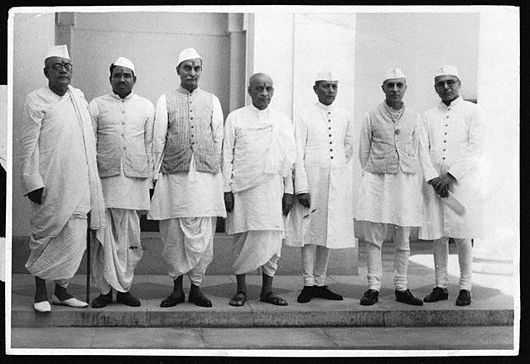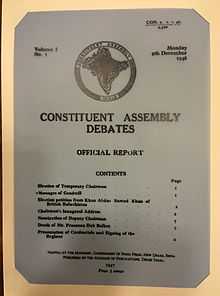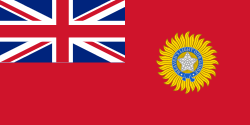Interim Government of India
Interim Government of India  | ||||||
| Transition between Imperiala and Democratic structureb | ||||||
| ||||||
| ||||||
| Anthem God Save the King | ||||||
The British Indian Empire in 1945. | ||||||
| Capital | New Delhi | |||||
| Languages | ||||||
| Government | Empire | |||||
| Emperor | ||||||
| - | 1946–1947 | George VI | ||||
| Governor-Generalc | ||||||
| - | 1946–1947 (first) | Lord Wavell | ||||
| - | 1947 (last) | Lord Mountbatten | ||||
| Secretary of State | ||||||
| - | 1946–1947 (first) | Lord Pethick-Lawrence | ||||
| - | 1947 (last) | Earl of Listowel | ||||
| Legislature | Executive Council | |||||
| Historical era | Decolonisation of Asia | |||||
| - | Established | 2 September 1946 | ||||
| - | Indian Independence Act | 15 August 1947 | ||||
| - | Partition of India | 15 August 1947 | ||||
| Area | ||||||
| - | 1947 | 4,226,734 km² (1,631,951 sq mi) | ||||
| Currency | British Indian rupee | |||||
| Today part of | ||||||
| a. | Composed of: (i) Presidencies and provinces directly governed by the British Crown through the Governor-General of India; (ii) Princely states governed by local Indian rulers under the suzerainty of the British Crown (exercised through the Governor-General of India).[1] | |||||
| b. | through Executive Council. | |||||
| c. | Full title was "Viceroy and Governor-General of India". | |||||
The interim government of India, formed on 2 September 1946 from the newly elected Constituent Assembly of India, had the task of assisting the transition of India and Pakistan from British rule to independence. It remained in place until 15 August 1947, the date of the independence of the two new nations of India and Pakistan.[2][3][4]
Formation
After the end of the Second World War, the British authorities in India released all political prisoners who had participated in the Quit India movement. The Indian National Congress, the largest Indian political party, which had long fought for national independence, agreed to participate in elections for a constituent assembly, as did the Muslim League. The newly elected government of Clement Attlee dispatched the 1946 Cabinet Mission to India to formulate proposals for the formation of a government that would lead to an independent India.[4]
The elections for the Constituent Assembly were not direct elections, as the members were elected from each of the provincial legislative assemblies. In the event, the Indian National Congress won a majority of the seats, some 69 per cent, including almost every seat in areas with a majority Hindu electorate. The Congress had clear majorities in eight of the eleven provinces of British India.[5] The Muslim League won the seats allocated to the Muslim electorate.
Viceroy's Executive Council
The Viceroy's Executive Council became the executive branch of the interim government. Originally headed by the Viceroy of India, it was transformed into a council of ministers, with the powers of a prime minister bestowed on the vice-president of the Council, a position held by the Congress leader Jawaharlal Nehru. After independence all members would be Indians, apart from the Viceroy, in August to become the Governor-General, Lord Mountbatten, who would hold only a ceremonial position, and the Commander-in-Chief, India,[4] Sir Claude Auchinleck, replaced after independence by General Sir Rob Lockhart.
The senior Congress leader Vallabhbhai Patel held the second-most powerful position in the Council, heading the Department of Home Affairs, Department of Information and Broadcasting.[6] The Sikh leader Baldev Singh was responsible for the Department of Defence and Chakravarthi Rajagopalachari was named to head the Department of Education and arts.[6] Asaf Ali, a Muslim Congress leader, headed the Department of Railways and Transport. Scheduled Caste leader Jagjivan Ram headed the Department of Labour, while Rajendra Prasad headed the Department of Food and Agriculture and John Mathai headed the Department of Industries and Supplies.[6]
Upon the Muslim League joining the interim government, the second highest-ranking League politician, Liaquat Ali Khan, became the head of the Department of Finance. Abdur Rab Nishtar headed the Departments of Posts and Air and Ibrahim Ismail Chundrigar headed the Department of Commerce.[6] The League nominated a Scheduled Caste Hindu politician, Jogendra Nath Mandal, to lead the Department of Law.[6]
Members of the Interim Government

The above is the reconstituted cabinet of 15 October 1946, when five Muslim League members (Liaquat, Chundrigar, Ghazanfar, Nishtar and Mandal) joined in the place of Congressmen Sarat Chandra Bose, Shafaat Ahmed Khan and Syed Ali Zaheer.[8]
Activities

Although until August 1947 British India remained under the sovereignty of the United Kingdom, the interim government proceeded to establish diplomatic relations with other countries, including the United States.[3] Meanwhile, the Constituent Assembly, from which the Interim Government was drawn, struggled with the challenging task of drafting a constitution for independent India.
References
- ↑ Interpretation Act 1889 (52 & 53 Vict. c. 63), s. 18.
- ↑ Vidya Dhar Mahajan (1971). Constitutional history of India, including the nationalist movement. S. Chand. pp. 200–10.
- ↑ 3.0 3.1 "Office of the Historian - Countries - India". U.S. State Department. Retrieved 2009-08-16.
- ↑ 4.0 4.1 4.2 Radhey Shyam Chaurasia (2002). History of Modern India, 1707 A. D. to 2000 A. D. Atlantic Publishers & Distributors. pp. 300–400. ISBN 978-81-269-0085-5.
- ↑ (Judd 2004, p. 172)
- ↑ 6.0 6.1 6.2 6.3 6.4 John F. Riddick (2006). The History of British India: A Chronology. Greenwood Publishing Group. pp. 100–150. ISBN 978-0-313-32280-8.
- ↑
- ↑ V. Krishna Ananth. India Since Independence: Making Sense of Indian Politics. Pearson Education India. 2010. pp 28–30.

